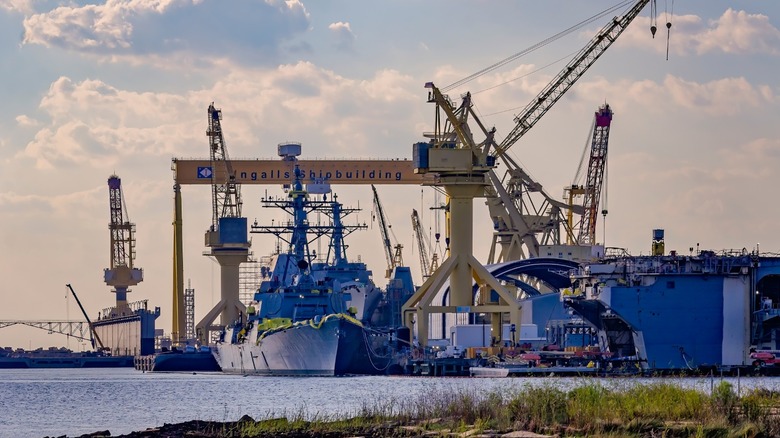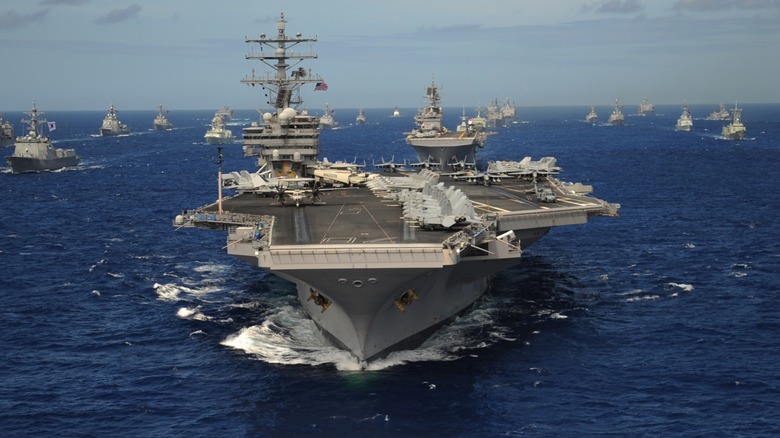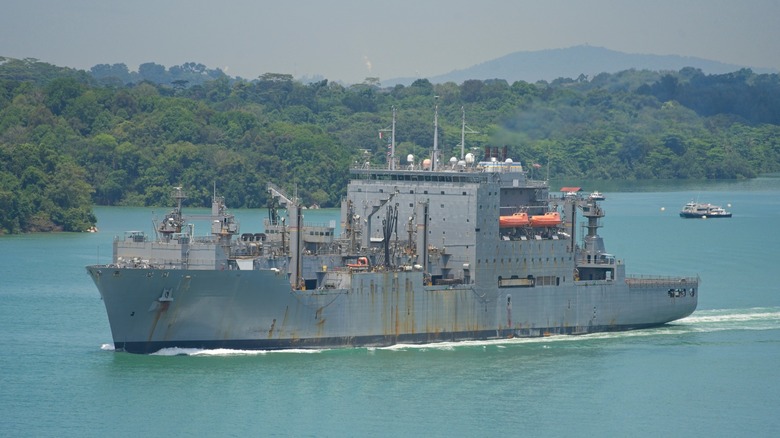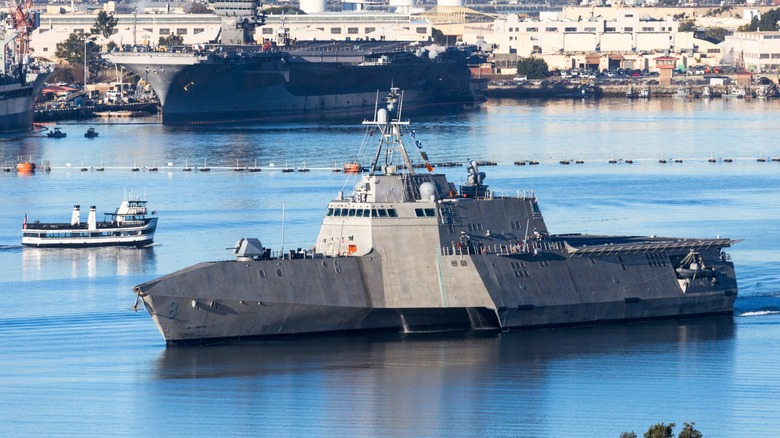
When you see videos of large Navy ships, floating fortresses cruising through the water carrying weapons and jets, it's hard to believe that a group of people somehow, somewhere came together to build them. Yet, that's exactly what's happened. Behind every steel hull and radar mast is a complex web of industrial giants, naval contracts, and specialized shipyards working with surgical precision. It might seem like it, but these aren't one-off feats, but products of centuries of steadily improving
technologies and craftsmanship.
However, none of the ships the U.S. Navy uses are directly made by them. Yes, the Navy owns some public shipyards, but they're for maintenance and overhauls. Instead, the government funds a group of private contractors to produce and, in many cases, also repair them. Some names rise above the rest. They're the ones behind the most impressive of vessels, raking in billions of dollars from just a single contract. Together, these companies form the backbone of America's naval shipbuilding industry, each specializing in different types of vessels. You might have heard of them: Huntington Ingalls Industries (HII), General Dynamics' (GD) Marine Systems subdivision, Fincantieri Marinette Marine, and a few others.
Read more: 10 Of The Largest Navies In The World, Ranked By Self-Reported Total Naval Assets
Who Makes The Big Ships?

When we say "big ships," we're referring to three main types of U.S. naval vessels: aircraft carriers, amphibious assault ships, and nuclear ballistic missile submarines (SSBNs). It doesn't mean the other categories are "small ships" by any means (these vessels are enormous), rather, these are really big relative to other types. Each of these types has special classes named after its lead ship. In the aircraft carrier type, we have the Gerald R. Ford-class and Nimitz-class, both built by HII -- the Ford-class being the newer generation and the largest in the world. All the current U.S. aircraft carriers are made by the Newport News Shipbuilding division of HII in Newport News, Virginia. For now, HII, a company formed by the merging of two legacy shipbuilding companies in 2011, is the only company that builds American aircraft carriers and has been making aircraft carriers for over 75 years.
The next type is amphibious assault ships, similar but different from aircraft carriers. They are designed to establish ground control instead of the mobile air base style of aircraft carriers. There are only two classes here, as well, the America-class and Wasp-class, also solely designed by HII, but this time by its Ingalls Shipbuilding division in Pascagoula, Mississippi. And lastly, while not a surface ship, SSBNs fall into the big naval vessel and warship category, earning a spot in this section. There are only two classes: Ohio-class and its replacement, Columbia-class. The Ohio-class was designed and built by General Dynamics Electric Boat (GDEB), while the Columbia-class is currently being built as a joint effort between HII Newport News (as a subcontractor) and GDEB.
Who Makes The Medium-Sized Attack Ships?

Our selection for medium attack ships is the more common vessels adopted by the U.S. Navy, smaller than the giant warships. This includes: destroyers, cruisers, amphibious transport docks, frigates, and attack submarines (SSNs). HII and General Dynamics also operate in the bigger end of this division, both behind many types of "medium-size" warships, including the Arleigh Burke-class destroyers through Ingalls Shipbuilding and General Dynamics Bath Iron Works. It looks like they'll also remain the contractors for the Burke-class in the foreseeable future, as they currently hold 5-year-long contracts for new destroyers awarded back in 2023.
These two companies also designed and built the now-phased-out Ticonderoga-class warship cruisers, although Ingalls Shipbuilding and Bath Iron Works, as we know them right now, didn't exist yet; rather, they were standalone pre-acquisition companies. Now partnered as HII, the Ingalls division exclusively fulfills contracts for San Antonio-class amphibious transport docks at the moment. The other legacy divisions of HII and GD (Newport News and Electric Boat, respectively) also built the current Virginia-class and Los Angeles-class attack submarines.
There are no frigates in the U.S. Navy's active service; all the ones built by Bath Iron Works (before it was acquired by General Dynamics) and Todd Shipyard were decommissioned in 2015 and now effectively replaced by Littoral Combat Ships (LCSs). However, the U.S. Navy is trying to revive frigates and awarded a contract to Fincantieri Marinette Marine in 2024 to build new Constellation-class frigates by 2030.
Who Makes The Medium-Sized Support Ships?

The medium-sized logistical support ships, for the sake of categorizing, are: dock landing ships, fleet replenishment oilers, cargo/ammunition ships, and towing & rescue ships. You might be surprised to see some familiar manufacturers also raking in contracts in this category. General Dynamics NASSCO, a company in GD's Marine Systems subdivision, built both the fleet replenishment oilers (John Lewis-class) and cargo/ammunition ships (Lewis and Clark-class). The U.S. Navy also awarded more contracts to NASSCO in 2024 to make eight more John-Lewis class replenishment oilers by 2035.
While the latest were commissioned as far back as 1998, there are Whidbey Island-class and Harpers Ferry-class dock landing ships still in service to date. These were built by companies that no longer exist by themselves: Lockheed Shipbuilding -- now closed up and absorbed into today's Lockheed Martin -- and Avondale Shipyard -- which somehow ended up in HII after acquisitions, mergers, and sellouts. The only shipbuilders in this section, separate from General Dynamics and HII, are the ones currently building the towing & rescue ships (aka fleet ocean tugs): Bollinger Shipyards and Austal USA. This new Navajo-class will replace the old Powhatan-class and Safeguard-class built by Marinette Marine and Peterson Builders, respectively -- since both these ship classes have reached the projected end of service life.
Who Makes The Small Ships?

Clearly, Huntington Ingalls Industries and General Dynamics hold a duopoly on the bigger ship contracts. But when it comes to the small ones, like the Littoral Combat Ships (LCS), expeditionary fast transports, support barges, and unmanned mine countermeasure USVs, a whole new group of companies is thriving here. The sleek, fast, and controversial LCS ships, designed for near-shore missions, fall into two classes: Freedom-class and Independence-class. The first class was designed by the renowned jet-building giant, Lockheed Martin, then built by Marinette Marine, and the latter was designed by a joint effort of General Dynamics and Austal USA, then built by Austal. So, there's some of the ubiquitous General Dynamics, but only as a guide in this sector rather than a sole contractor.
Austal USA also won the contracts for expeditionary fast transport (EPF) vessels, a relatively new line of ships, remixed from what was formerly known as Joint High Speed Vessels (JHSV). These non-combat ships are designed to transport up to 312 troops, military vehicles, and reasonably-sized payloads at a max speed of 32 knots. When personnel and sailors need somewhere to stay when ships are docked or undergoing maintenance, that's where Auxiliary Personnel Lighters (APL) berthing and messing barges come in. So far, it's Bollinger Shipping Yards that makes them for the Navy. The previous set was built by VT Halter Marine, which was acquired by Bollinger in 2022. This same company also built the first non-prototype mine countermeasures unmanned surface vehicles (MCM USVs) for the Navy and delivered three of them earlier in 2025.
Want the latest in tech and auto trends? Subscribe to our free newsletter for the latest headlines, expert guides, and how-to tips, one email at a time.
Read the original article on SlashGear.












